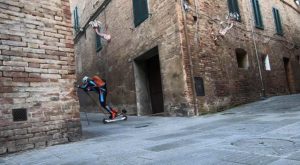
Marina Mangubi exhibits Painting Biathlon at Smith College

Marina Mangubi, professor of studio art at The College of Wooster, combined her love of skiing and painting in a performance art series titled Painting Biathlon. The project comprises paintings, drawings, intaglio and digital prints, and performative videos. She created the artwork across seven years in three different locations: Banff, Canada; Joshua Tree National Park, southern California; and Siena, Italy. Now through Oct. 6, a selection of her visual and performance art from the series is featured in an exhibition at Smith College’s Oresman Gallery in Northampton, Massachusetts.
The exhibition includes an installation of 12 paintings and two video projections, accompanied by five small drawings on DiBond from Banff, two intaglio prints and a set of digital prints titled Standing Targets from Joshua Tree, and videos from each of the three sites. The series continues her pursuit of thematic projects and follows two previous projects “that are different but relevant,” said Mangubi, who is a painter, printmaker, and performance artist.
The first thematic project that influenced the Painting Biathlon series was borne from a story about the dissemination of Western popular music behind the Iron Curtain after World War II. Her father relayed how gramophone records were cut onto discarded X-rays in the wake of the war.
“I became intrigued and started thinking about making images to reflect the narrative, like turning the memories of the massacre into pleasure. I also wanted to encompass the physicality of the cutting or pressing of the records,” said Mangubi. From the story, she created a print series called Music “on the Bones.” “The historical connotations and the notion of how images are time stamped have continued into the Painting Biathlon project,” she said.
Another long-term project that preceded the Painting Biathlon artwork was Eight Board Feet, a series of landscapes on two-by-fours, inspired by the Golden Age landscapes of the 17th Century artist Jacob van Ruisdael and concomitant discoveries in mathematics and science. “I found it interesting how he built the models of nature that reflected its properties without being its copy,” Mangubi said. From the project Eight Board Feet to Painting Biathlon, she borrowed the sense of moving through the landscape, sensing it, assimilating it, and creating this mental model that includes an important temporal component. After toiling over paintings that would each take a year to make, Mangubi needed a project she could do quickly.
“I had been skiing since I was two years old and painting since I was six. I had never connected the two loves of mine, and suddenly I had the idea about biathletes engaging in a similar task combining physicality with great precision,” she said. “Could I interpret the endurance, the controlled form and focus that is required in the sport of biathlon in my artwork?”

She started the series during her 2015 residency at the Banff Centre in Canada. Working at the nearby Canmore Nordic Centre that was built for the 1988 Calgary Olympics, she combined cross-country skiing and painting in the way biathletes combine skiing and rifle shooting. Emulating the racecourse, Mangubi set up painting stations along the cross-country ski track, skied 2.5-kilometer sprints, and stopped to make a quick painting within 15 minutes before sprinting to the next station. The process at Joshua Tree National Park and Siena was similar except, absent snow, she roller skied on sandy desert floor and the ribbed stone of the old city. Video of her performance was taken in each setting and is included in the exhibition.
“Just like a dancer, the skier responds to the feel of the surface, the terrain, to the movement around and to the elements. I make that connection explicitly when I’m making a painting,” she said. “The paintings serve to attract audiences and engage with them on questions of history and politics related to the sport—a leading issue being climate change, which impacts all skiers who depend on snow for training. The message of vulnerability and resilience sets the stage of an artist as an athlete.”
Image: Outtake, 2019
Posted in Faculty, News on September 7, 2022.
Related Posts
Related Areas of Study
Art - Studio Art
Studio space, small classes with talented instructors, and the strong foundation that comes with a liberal arts education.
Major MinorArt - Art History
Explore the cultural and historic significance of art and artists while building research and analytical skills.
Major Minor

